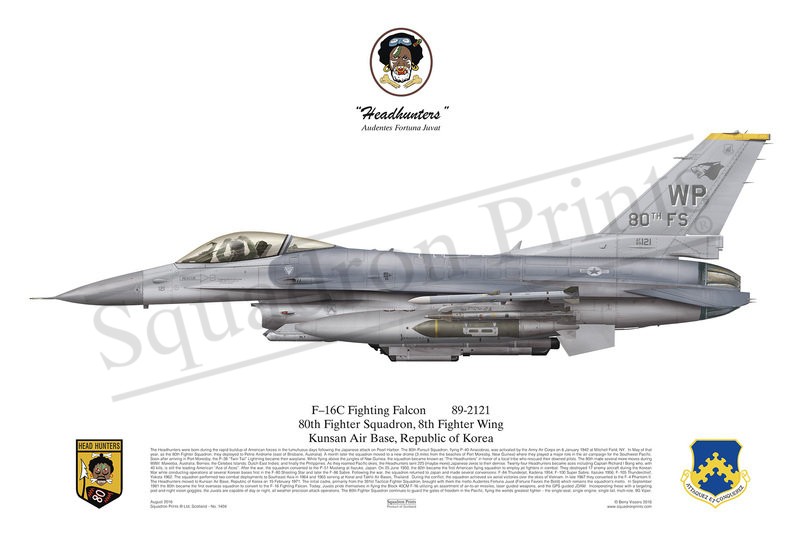#1404 F-16C Fighting Falcon

Purchased products will not feature the Squadron Prints watermark
Description
Squadron Prints Lithograph No. 1404 - 89-2121, F-16C Fighting Falcon, 80th Fighter Squadron, 8th Fighter Wing, Kunsan Air Base, Republic of Korea.
The Headhunters were born during the rapid buildup of American forces in the tumultuous days following the Japanese attack on Pearl Harbor. The 80th Pursuit Squadron, flying P–40 Airacobras, was activated by the Army Air Corps on 6 January 1942 at Mitchell Field, NY. In May of that year, as the 80th Fighter Squadron, they deployed to Petrie Airdrome (east of Brisbane, Australia). A month later the squadron moved to a new drome (3 miles from the beaches of Port Moresby, New Guinea) where they played a major role in the air campaign for the Southwest Pacific. Soon after arriving in Port Moresby, the P–38 “Twin Tail†Lightning became their warplane. While flying above the jungles of New Guinea, the squadron became known as “The Headhunters†in honor of a local tribe who rescued their downed pilots. The 80th made several more moves during WWII: Mareeba, Australia; Borneo; the Celebes Islands; Dutch East Indies; and finally the Philippines. As they roamed Pacific skies, the Headhunters sent 225 (maybe more) Japanese zeros to their demise. Twenty-four Headhunters became aces including Captain Richard I Bong who, with 40 kills, is still the leading American “Ace of Acesâ€. After the war, the squadron converted to the P–51 Mustang at Itazuke, Japan. On 25 June 1950, the 80th became the first American flying squadron to employ jet fighters in combat. They destroyed 17 enemy aircraft during the Korean War while conducting operations at several Korean bases first in the F–80 Shooting Star and later the F–86 Sabre. Following the war, the squadron returned to Japan and made several conversions: F–84 Thunderjet, Kadena 1954; F–100 Super Sabre, Itazuke 1956; F–105 Thunderchief, Yokota 1962. The squadron performed two combat deployments to Southeast Asia in 1964 and 1965 serving at Korat and Takhli Air Bases, Thailand. During the conflict, the squadron achieved six aerial victories over the skies of Vietnam. In late 1967 they converted to the F–4 Phantom II. The Headhunters moved to Kunsan Air Base, Republic of Korea on 15 February 1971. The initial cadre, primarily from the 391st Tactical Fighter Squadron, brought with them the motto Audentes Fortuna Juvat (Fortune Favors the Bold) which remains the squadron's motto. In September 1981 the 80th became the first overseas squadron to convert to the F–16 Fighting Falcon. Today, Juvats pride themselves in flying the Block 40CM F-16 utilizing an assortment of air-to-air missiles, laser guided weapons, and the GPS guided JDAM. Incorporating these with a targeting pod and night vision goggles, the Juvats are capable of day or night, all weather precision attack operations. The 80th Fighter Squadron continues to guard the gates of freedom in the Pacific, flying the worlds greatest fighter – the single-seat, single engine, single tail, multi-role, 9G Viper.
You may also like
-
3 Squadron Red Flag 24-1 PVC Patch (1 per person)
3 SqnNellis AFB, Nevada; RAF Coningsby -
333 FGS F-15E Strike Eagle print
87-0199333 FS, 4 FWSeymour-Johnson AFB, North Carolina
